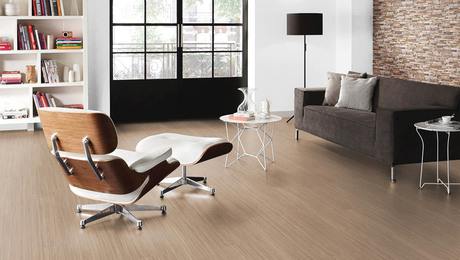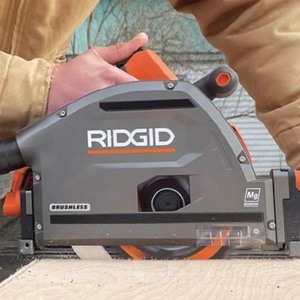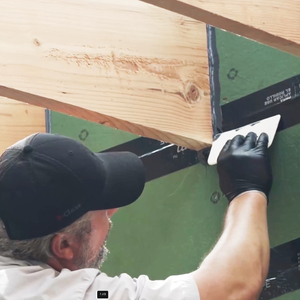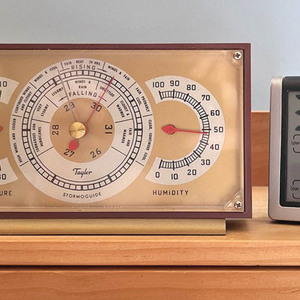OK, I know that sounds like a really dumb question. It probably is. ;o)
After researching some railing options for our front steps, I decided to take the cheap way out and go for the ‘industrial’ look and use standard pipe for the actual rail. I have a choice between Galvanized and Black pipe (and, well, copper, but that’s not a cheap option anymore).
What is the better option for outdoor use? I’m not really sure what makes black pipe what it is. Are one of the two options more easily painted down the road?


















Replies
Both "black pipe" and galvanized are steel. Black pipe is painted black, galvanized is coated with zinc.
The galvanized pipe will barely rust at all, developing some light rust where the threads have cut through the coating or where the coating is damaged. Over time, constant use as a handrail can wear through the coating and the railing will develop rust where it 's worn away.
The paint on black pipe is a light coating and provides only the barest protection. Black pipe will rust outdoors.
You can paint either but they take different primers. The black pipe will need sanding and priming with a steel primer. Galvanized pipe won't need much or any sanding, but you have to use a primer specifically formulated for galvanized.
In either case you have to remove oil from the thread cutting operation using a solvent.
I've heard that before painting galvy metal you should etch it with vinegar so that you have a better bond. Does anyone know anything definitive about doing that? Does it matter whether it's white or regular vinegar?
I've heard that black pipe only likes the good balsamic vinegar, the $200 / pint stuff...Seriously I'm only guessing but I would think acetone or lacquer thinner would clean off the oil and any other impurities.
I didn't mean to clean the oil off Bryan, but to etch the galvey coating for a better paint bond.
Ah, I see now. I would imagine that sandblasting would be the only sure fire way to etch, but that is just a guess. I agree with the powder coating idea - lots more longevity.
But what would you use to clean the oil off Bryan?
If Tyranny and Oppression come to this land, it will be in the guise of fighting a foreign enemy. --James Madison
Ospho is a good choice for that, too.
http://www.ospho.com/
GALVANIZED - where appearance is important, apply one coat of OSPHO, let stand for approximately thirty minutes or until metal is etched. Flush with water, avoiding damage to adjacent areas; or wipe to a smooth finish, let dry, then paint. Where appearance is not important, one coat of OSPHO is recommended to thoroughly coat and etch the metal. Let stand overnight or until completely dry. Brush off any loose powder before painting.
A typical paint application will last much longer after an application of OSPHO because subsequent paint coatings attach themselves so tightly that moisture and oxygen cannot attack the metal. OSPHO is water-thin, and therefore goes on easily and covers a larger area than paint. One gallon covers approx. 600 square feet. Historically, best results have been achieved using an oil-base primer and topcoat. Test a trial sample before using under epoxy or latex-base paint applications. OSPHO is equally effective for exterior and interior work alike and is highly recommended as a pre-treatment coating by leading paint manufacturers.
For best results, use OSPHO at temperatures no lower than 36 degrees F. Excessive dew and humidity may prolong drying time and cause powdery buildup.
Spray equipment should be flushed out with water after using. Clean brushes with water. Avoid getting OSPHO on adjacent areas such as painted surfaces, concrete, masonry and stonework. If splashing occurs, flush immediately with water to remove.
When I worked in the sheet metal shop, we would etch galvanized with Muriatic acid and then apply a good auto body type primer and paint the surfaces. You need to wash off the acid real well, but we didn't neutralize it. We would usually do the etching in the morning and let it dry until the mid afternoon or if inside, until the next day.
I don't recall the concentration of acid, but I assume the stuff used to clean bricks would work just fine.
I've washed galvanized stuff in soap and water followed by a TSP rinse. When it's dry spray a good metal primer (i.e. Rustoleum) and paint. Most of my painted galvy has lasted for years.
Thanks Dave, but I'm still wondering if anyone else has heard about using vinegar for the etching. Makes sense to me, being an acid, and it also makes sense about how it might help in paint bonding, but I'd still like to hear some confirmation.
The OSPHO that someone recommended is another type of acid, phosphoric. It's the same acid that's in naval jelly.
Joe, yes to white vinegar.
It's worked for me. Have only used it interior.A great place for Information, Comraderie, and a sucker punch.
Remodeling Contractor just outside the Glass City.
Quittin' Time
OK! thanks Calvin! I notice when I do it that it turns the galvy a little bit gray.I've been doing this to my ZMax connectors before I paint them with Rustoleum flat black.would there be a better choice for the paint??
Choice of paint? My experience has been that any paint has worked for a finish coat after first a good metal primer.A great place for Information, Comraderie, and a sucker punch.
Remodeling Contractor just outside the Glass City.
Quittin' Time
Look at the acid % not the actual name of vinegar...most are about 5-6% Acetic acid, some can be less, in food canning, the difference is life and death.
Spheramid Enterprises Architectural Woodworks
There is no cure for stupid. R. White.
The vinegar thing is what a painter did who I had paint some galvanized metal dumpster enclosure doors. Not sure what type he used.
Hey - For what its worth, distilled white vinegar is what I have alwaysed used. Its slightly acidic, enough to remove any grease which might be left from manufacturing. I learned this as an apprentice back in the eighties. I havent investigated new products but I've never had a problem using this old school method. The nice thing about vinegar is that its probably one of the least toixic products you can use. And its cheap!Parkinson's Law: 'Work expands so as to fill the time available for its completion.'
Use balsamic vinegar only if you will paint with dark color :)The surface coating on black pipe is lacquer - just enough to keep it from rusting during shipping and in the warehouse. Neither oil-base nor latex paints adhere to lacquer, so thorough sanding would be necessary before painting black pipe.Paint adhesion to zinc (that's what galvanized is) is poor at best, so the surface must be etched. Vinegar will work as would any mild acid to etch the zinc enough to provide "tooth" for the primer in order to provide a mechanical bond. Industrial paint operations use phosphoric acid, cut back with alcohol, as a quick-drying etching solution or they may add phosphoric to the paint itself.By the way, think about phosphoric acid etching metal the next time you swirl your favorite tangy soda around your teeth before swallowing it. Coke, Pepsi, Squirt and others use phosphoric acid to give them a thirst-quenching "bite".BruceT
Edited 6/18/2006 5:20 pm ET by BruceT999
"By the way, think about phosphoric acid etching metal the next time you swirl your favorite tangy soda around your teeth before swallowing it. Coke, Pepsi, Squirt and others use phosphoric acid to give them a thirst-quenching "bite"."Proper amounts for all applications.While often use vinegar in/on my food, I would hate to take a slug of 100%.Likewise a rubarb pie is good. But it also contains oxcilic (sp?) acid which is used as a deck brightener, among other things, and is dangerous in high quanities.You can also get water intoxication.
Good balsamic is actually for drinking. Kinda an after dinner cordial.But me? I'll stick to single malt.
Thanks again for all teh feedback everyone.Follow up...I connected all the pipe and then sprayed it all down with vinegar and scrupped the oil off. 5 days later, the galvanized part is a bit duller, but all the threads are now rusting. I went to a paint shop and they recommended to particular paints...a metal primer made for galvanized and then a water-based gloss black (both Krylon products).Here's the catch, according to the paint place, the pipe should first weather for 6 months before using the primer, or, alterantively, I can acid etch it with some really nasty stuff.My question...is a couple coats of vinegar good enough/equal to 6 months of aging? Or should I hold out for 6 months of aging? If I do the 6 month thing, should I go back and recoat the threads with a galvanizing primer (to allow that to also weather for 6 months?)I really don't want to use the toxic stuff. I'm clumsy and with kids, and then I'd have to store it and all that... ;o)
Ask him why. Remeber, many of the guys who sell the stuff have never applied it. that goes for a few things in life I suppose.Parkinson's Law: 'Work expands so as to fill the time available for its completion.'
Well he was just reading the manufacturer's notes off the computer screen. He didn't have any experience himself.I guess my question is if a vinegar bath = 6 months of natural weathering.
That lemon slice in your Iced Tea will eat more dentin in 3 seconds than a case of coke.
Spheramid Enterprises Architectural Woodworks
There is no cure for stupid. R. White.
I would wash black pipe with soap and water before painting/priming because it is coated with oil to retard rusting during shipping and shelf time.
Another option would be to cut it and thread, if needed.They find an industrial painting job shop that will do powder coating.Lots of outdoor metals (lawn furniture, garden tools, railings, etc) are powder coated and last a LONG TIME.
its pipe thats black
Thanks, all. Bill...good idea. I might do that.
The black coating on plumbing pipe takes a bit to get everything clean as it isn't a simple matter of wiping it down. I have pipe clamps using black plumbing pipe that still rub black off after years of use. The coating is not durable and is a pain to sand completely off.
A better option is going with a normal steel tubing of the right diameter. It paints well, is available in any size, and from a used steel outlet is as cheap as any plumbing pipe. I used to pay $.10 a pound for any shape or size that was in stock.
While you're at the salvage yard, pay them $20 or so and have some decent flanges welded on so it looks like a well thought out rail, instead of a budget saving cost cut.
Even having a welding truck out to attach the thing might only run $50 or so.
Good railing.
"Black" pipe comes in several different surface treatments. Some black pipe has been blackened by forming iron phosphate on the surface, which gives a little bit of corrosion protection compared with bare steel. But most of the pipe we see these days is just steel pipe coated with a thin layer of a lacquer. This lacquer layer is to keep it from rusting in the yard while it sits waiting to be used. It's not a durable coating and it should be removed before over-coating with paint of any kind. If you're using "black" pipe, the only way to get a really good bond is to sandblast first.
Hollow structural steel (steel "tubing") is available in pipe outside dimensions but with different wall thicknesses (in fractions of an inch instead of "schedules"). This material is better for handrail because it comes bare with only an easily-removed oil coating. It's also got a much nicer surface finish than most pipe, and is generally cheaper than new pipe.
If you want galvanized pipe, you can save a few bucks if your supplier carries some "off-spec" pipe. This is pipe which has failed some of the tests required for the pipe to be used as pressure piping, but is still fine to use for purposes such as handrail.
The biggest advantage of galvanized pipe is that it is coated both inside and outside with zinc which protects the steel by acting as a sacrificial anode. Handrails are notorious for filling up with water and rotting from the inside out, so weep holes are a good idea in the bottom of any vertical section. If you want to over-coat galvanized pipe, unless it's old weathered pipe, don't bother etching it with any acid, because that will just dissolve away some of the zinc and reduce the amount left for protection. Instead, use a converting primer intended for use over galvanized material. There are several different brands, available in spray bombs or in regular cans.
If you want to leave the galvanized material exposed without painting it, you should use cold galvanizing spray over your threads after you cut them. This will keep the threads from rusting as quickly and make the railing look nicer when it's done.
If you're going to go to the expense of powder coating, do it in the assembled condition. Galvanized doesn't powder coat well because the coating can be porous and lead to bubbles in the finish. Best to use HSS tube or black pipe and sandblast it first.